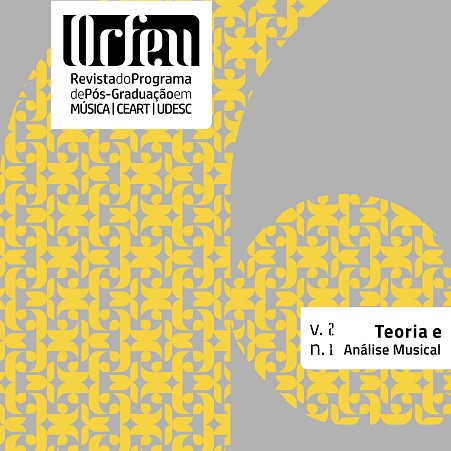Schenker’s Fließender Gesang and the Concept of Melodic Fluency
DOI:
https://doi.org/10.5965/2525530402012017160Palavras-chave:
teoria musical, música - análise, apreciação, análise schenriana, melodiaResumo
The concept of melodic fluency is considered today an important one in Schenkerian theory. William Pastille (1990:71-72) shows that this notion, first presented in the first volume of Counterpoint, initiated the development of the Ursatz concept. The knowledge of the principle of melodic fluency, he adds, affords two abilities: “the ability to uncover long-range melodic motions and the ability to reveal underlying contrapuntal patterns”, which “became the mainstays of his analytical approach.” Allen Cadwallader and William Pastille (1992:120) confirm that Schenker “formally introduced” the concept of melodic fluency in Counterpoint I, and define it as “essentially a name for good voice leading in strict counterpoint”. William Rothstein, who defines Schenker’s concept of melodic fluency as a “stepwise continuity in the upper voice” (1991:292), makes it an essential element of his description of “implied tones”, when a conjunct tone is implied in an apparently leaping melodic line.
Downloads
Referências
ALBRECHTSBERGER, Johann Georg (1790). Anweisung zur Komposition. Leipzig, Breitkopf.
CADWALLADER, Allen, and William PASTILLE (1992). “Schenker’s High-Level Motives”. Journal of Music Theory 36/1, pp. 119-148.
CHERUBINI, Luigi [c1835]. Cours de contre-point et de fugue / Theorie des Contrapunktes und der Fuge, aus dem Fransösischen übersetzt von Dr. Franz Stoepel. Leipzig, Kistner, Paris, Schlesinger. New translation by Gustav Jensen, Cologne and Leipzig, Vom Ende’s Vlg, 1896.
COHN, Richard (1998). “Introduction to Neo-Riemannian Theory: A Survey and a Historical Perspective”. Journal of Music Theory 42/2 (1998), pp. 167-180.
COOK, Nicholas (2007). The Schenker Project. Culture, Race, and Music Theory in Fin-de-siècle Vienna. Oxford, Oxford University Press.
DÜRRNBERGER, Johann August (1841). Elementar-Lehrbuch der Harmonie- und Generalbass-Lehre. Linz, Normal Hauptschule.
FUX, Johann Joseph (1725). Gradus ad Parnassum. Vienna, Joannes Petrus Van Ghelen.
[HINTERBERGER, Heinrich (n.d.)]. Katalog XI. Musik und Theater. Enthaltend die Bibliothek des Herrn † Dr. Heinrich Schenker, Wien.
KIRNBERGER, Johann Philipp (1776). Die Kunst des reinen Satzes in der Musik, vol. II. Berlin, Königsberg, Decker.
MATTHESON, Johann (1739). Der vollkommene Capellmeister. Hamburg, Christian Herold.
MORGAN, Robert (2014). Becoming Heinrich Schenker. Music Theory and Ideology. Cambridge University Press.
PANKHURST, Thomas (2008). Schenker Guide. A Brief Handbook and Website for Schenkerian Analysis. New York, London, Routledge.
PASTILLE, William (1990). “The Development of the Ursatz in Schenker’s Published Works”. Trends in Schenkerian Research, Allen Cadwallader ed., New York, Schirmer, pp. 71-85a.
RAMEAU, Jean-Philippe (1722). Traité de L’Harmonie Reduite à ses Principes naturels. Paris, Ballard.
ROTHSTEIN, William (1991). “On Implied Tones”. Music Analysis 10/3, pp. 289-328.
SCHEIBE Johann Adolph (1738). Critischer Musikus, vol. I. Hamburg, von Wierings Erben.
SCHENKER, Heinrich (1906/1954). Harmonielehre. Stuttgart and Berlin, Cotta, 1906.
Downloads
Publicado
Como Citar
Edição
Seção
Licença
Copyright (c) 2017 ORFEU

Este trabalho está licenciado sob uma licença Creative Commons Attribution 4.0 International License.





